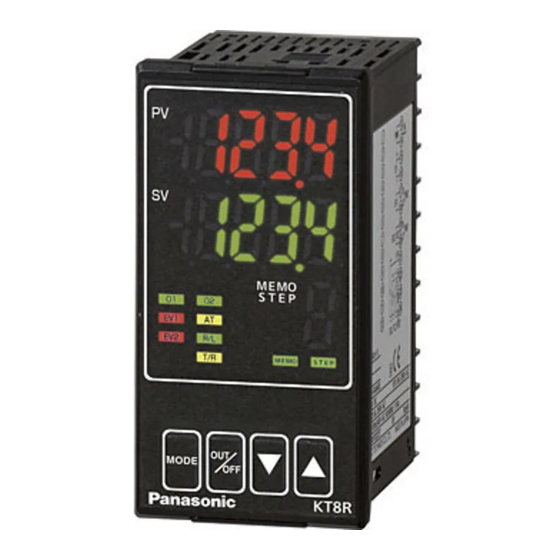
Summarization of Contents
Safety Precautions
Warning
Procedures that may lead to death or serious injury if not carried out properly.
Caution
Procedures that may lead to injury or physical damage if not carried out properly.
Installation Precautions
Environmental and mounting requirements for safe installation.
Wiring Precautions
Do not touch live terminals
Warning against electric shock from live terminals.
Use solderless terminal
Guidance on using appropriate terminals for wiring.
Operation and Maintenance Precautions
It is recommended that AT be performed
Recommends performing Auto-Tuning during trial run.
Model Number
How to Read the Rated Label
Details how to interpret the information on the rated label.
Mounting to the Control Panel
External Dimensions
Provides physical dimensions for KT4R, KT8R, and KT9R models.
Panel Cutout
Specifies panel cutout dimensions for installation.
Mounting to, and Removal from, the Control Panel
Instructions for mounting and removing the unit from the control panel.
Wiring
Terminal Arrangement
Shows the terminal layout for KT4R and KT8R/KT9R models.
Input
Shows wiring diagrams for various input types.
Outline of Key Operation and Each Mode
Key Operation
Explains how to operate the unit using its keys.
Modes
Describes different operating modes like RUN, Monitor, and settings modes.
Basic Operation after Power-ON
Guides through the initial steps after powering on the unit.
Initial Settings
Initial Setting Mode
Details how to enter and use the initial setting mode.
Settings
Main Setting Mode
Explains how to access and use the main setting mode.
Sub Setting Mode
Details how to enter and use the sub setting mode.
Engineering Mode 1
Explains how to enter and use Engineering Mode 1.
Engineering Mode 2
Explains how to enter and use Engineering Mode 2.
Operation and Settings of Standard Functions
Selecting an input type
Guides on selecting the appropriate input type.
Selecting PID Control or ON/OFF Control
Explains how to choose between PID and ON/OFF control.
Selecting Direct/Reverse Action
Details how to select direct or reverse control action.
Setting PID Constants (by Performing AT)
Explains setting PID constants using Auto-Tuning.
Performing Program Control
Guides on setting up and running program control sequences.
Attached Function
Input Value Correction
Corrects sensor input values for accuracy.
Set Value Lock
Protects set values from accidental changes.
Control Output OFF Function
Allows turning control output ON or OFF without powering down.
Switching Auto/Manual Control (Auto/Manual Control Function)
Enables switching between Auto and Manual control modes.
Using as a Converter
Describes using the controller as a signal converter.
2DOF PID Control
Implements 2 degrees of freedom PID control.
Action Explanation
OUT1 Action
Explains the behavior of OUT1 in heating/cooling control.
Alarm Action
Details how alarms function for different types.
OUT2 (Heating/Cooling Control) Action
Explains OUT2 behavior in heating/cooling control.
Specifications
Standard Specifications
Lists general specifications like input types, ranges, and voltage.
Specified Specifications
Details specific operational and physical specifications.
Troubleshooting
Indication
Solves problems related to display indications and error codes.
Key Operation
Addresses issues related to button functionality.
Control
Solves problems with temperature control and output status.
Character Table
Error Code
Lists error codes and their meanings.
Initial Setting Mode
Displays characters and ranges in initial setting mode.
Key Operation Flowchart
Key Operation
Summarizes key combinations and their functions.
















Need help?
Do you have a question about the KT9R and is the answer not in the manual?
Questions and answers